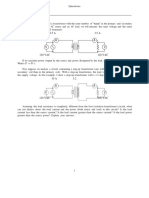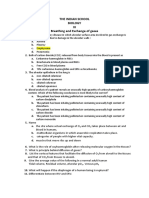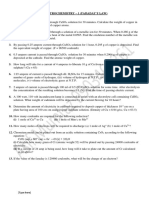0 ratings0% found this document useful (0 votes)
57 viewsThermal Properties of Matter Worksheet
Thermal Properties of Matter Worksheet
Uploaded by
Sajjan BalasubramanyanThis document contains a question bank for a physics exam, divided into 2-mark and 3-mark questions. The 2-mark questions cover topics like absolute zero, specific heat capacity, blackbody radiation, heat transfer between bodies of different temperatures, and the effects of pressure on melting points. The 3-mark questions require more detailed explanations, covering Stefan's and Wein's laws of radiation, thermal conduction, gas laws, calorimetry, heat capacities of solids and gases, coefficients of expansion, and latent heat of fusion.
Copyright:
© All Rights Reserved
Available Formats
Download as PDF, TXT or read online from Scribd
Thermal Properties of Matter Worksheet
Thermal Properties of Matter Worksheet
Uploaded by
Sajjan Balasubramanyan0 ratings0% found this document useful (0 votes)
57 views1 pageThis document contains a question bank for a physics exam, divided into 2-mark and 3-mark questions. The 2-mark questions cover topics like absolute zero, specific heat capacity, blackbody radiation, heat transfer between bodies of different temperatures, and the effects of pressure on melting points. The 3-mark questions require more detailed explanations, covering Stefan's and Wein's laws of radiation, thermal conduction, gas laws, calorimetry, heat capacities of solids and gases, coefficients of expansion, and latent heat of fusion.
Original Title
Thermal properties of matter worksheet
Copyright
© © All Rights Reserved
Available Formats
PDF, TXT or read online from Scribd
Share this document
Did you find this document useful?
Is this content inappropriate?
This document contains a question bank for a physics exam, divided into 2-mark and 3-mark questions. The 2-mark questions cover topics like absolute zero, specific heat capacity, blackbody radiation, heat transfer between bodies of different temperatures, and the effects of pressure on melting points. The 3-mark questions require more detailed explanations, covering Stefan's and Wein's laws of radiation, thermal conduction, gas laws, calorimetry, heat capacities of solids and gases, coefficients of expansion, and latent heat of fusion.
Copyright:
© All Rights Reserved
Available Formats
Download as PDF, TXT or read online from Scribd
Download as pdf or txt
0 ratings0% found this document useful (0 votes)
57 views1 pageThermal Properties of Matter Worksheet
Thermal Properties of Matter Worksheet
Uploaded by
Sajjan BalasubramanyanThis document contains a question bank for a physics exam, divided into 2-mark and 3-mark questions. The 2-mark questions cover topics like absolute zero, specific heat capacity, blackbody radiation, heat transfer between bodies of different temperatures, and the effects of pressure on melting points. The 3-mark questions require more detailed explanations, covering Stefan's and Wein's laws of radiation, thermal conduction, gas laws, calorimetry, heat capacities of solids and gases, coefficients of expansion, and latent heat of fusion.
Copyright:
© All Rights Reserved
Available Formats
Download as PDF, TXT or read online from Scribd
Download as pdf or txt
You are on page 1of 1
CHAPTER 11
QUESTION BANK
2 MARKS
1. What is absolute zero?
2. Define specific heat capacity.
3. Define molar specific heat capacity.
4. Define a blackbody. Draw the diagram of Ferry’s black body.
5. Two bodies of specific heat C1 and C2 having same heat capacities are combined to for a single
composite body. What is the specific heat of the composite body?
6. Why snow is a better heat insulator than ice?
7. Two bodies of different temperatures T1 and T2, if brought in thermal contact, do not necessarily
settle the mean temperature (T1+T2)/2. Why?
8. Show graphically how the energy emitted room a hot body varies with the wavelength of
radiation. Give some of the salient points of the graph.
9. A piece of paper wrapped tightly on a wooden rod is observed to get charred quickly when held
over a flame as compared to a similar piece of paper when wrapped on a brass rod. Explain why?
10. When pressure is increased, the melting point of ice is decreased on the other hand, the melting
point of wax increases with increase in pressure. Why?
3 marks:
1. Define Stefan’s law and Wein’s displacement law.
2. Explain thermal conduction. Write an expression for rate of heat flow between two opposite
faces of a slab of a homogeneous material whose two faces are maintained at a difference in
temperature of ΔT.
3. What are the two principal specific heats of a gas? Explain the relation between them.
4. State the principle of calorimetry. Explain how specific heat capacity of a solid can be
determined using the principle of mixtures.
5. Explain why Cp > Cv?
6. What are the three coefficient of expansion? Establish the relationship between the three.
7. Define what is meant by latent heat of fusion of ice. Give the factors on which the latent heat of
fusion of depends upon. Plot the graph showing the variation of temperature Vs heat from water
at 1 atmosphere pressure.
8. Cooling is difficult on hills. Why? How can we overcome this effect?
**********
You might also like
- 4 - Reading An Analog Voltmeter Problem WorksheetDocument1 page4 - Reading An Analog Voltmeter Problem WorksheetAndrew WaiNo ratings yet
- 1 Worksheet (AS) KinematicsDocument3 pages1 Worksheet (AS) KinematicsMahad AsimNo ratings yet
- 3 Vector Worksheet PDFDocument3 pages3 Vector Worksheet PDFnabil anwar16 Anwar Year 10100% (1)
- Transformers Worksheet G9Document6 pagesTransformers Worksheet G9Prayogo DidiNo ratings yet
- Trig Equations PDFDocument8 pagesTrig Equations PDFBalakrushna SahuNo ratings yet
- 13 2 WorksheetDocument5 pages13 2 Worksheetapi-235225555No ratings yet
- Chapter 7 Bank ReconciliationDocument17 pagesChapter 7 Bank ReconciliationDavid WongNo ratings yet
- Business Math Batch 18 Final ExamDocument5 pagesBusiness Math Batch 18 Final ExamDalia Ala EldenNo ratings yet
- Business Mathematics-1Document7 pagesBusiness Mathematics-1Dalia Ala EldenNo ratings yet
- Maths Coordinate GeometryDocument5 pagesMaths Coordinate GeometryMuhammad MustafaNo ratings yet
- Vectors - WorksheetDocument4 pagesVectors - WorksheetKaviraaj PremanandNo ratings yet
- Temp Conversion WorksheetDocument1 pageTemp Conversion WorksheetEJ DelimaNo ratings yet
- 8.05 Little - Ice - Age - worksheetCOMPLETEDocument2 pages8.05 Little - Ice - Age - worksheetCOMPLETEalexaNo ratings yet
- P4 Angle 8 Point Compass - AssignmentDocument6 pagesP4 Angle 8 Point Compass - AssignmentAurilia PrasidhaniNo ratings yet
- Lesson 4 - Electrostatic Force WorksheetDocument1 pageLesson 4 - Electrostatic Force WorksheetAnonymous jDrrLjraNo ratings yet
- Student Worksheet: "The Principle of Black"Document4 pagesStudent Worksheet: "The Principle of Black"Erna RisfaulaNo ratings yet
- Worksheet Vector Igcse Grade 9Document9 pagesWorksheet Vector Igcse Grade 9何小霞No ratings yet
- Exercise Grade 7Document3 pagesExercise Grade 7dekagielNo ratings yet
- Worksheet 3 (Domain and Range of A Function)Document4 pagesWorksheet 3 (Domain and Range of A Function)MOHAMMED S. S. SHATNo ratings yet
- Density WorksheetDocument2 pagesDensity WorksheetshamsNo ratings yet
- Worksheet 15: Scale Drawings, Bearings and Trigonometry: Answers To Core Revision Exercises: Shape, Space and MeasuresDocument2 pagesWorksheet 15: Scale Drawings, Bearings and Trigonometry: Answers To Core Revision Exercises: Shape, Space and Measuresmk hat100% (1)
- Order of Operations: Math WorksheetsDocument2 pagesOrder of Operations: Math WorksheetsLithurshaNo ratings yet
- 7.1.2 The Human Respiratory System PDFDocument2 pages7.1.2 The Human Respiratory System PDFKelvin RequenaNo ratings yet
- Worksheet 3 - Pressure of GasDocument5 pagesWorksheet 3 - Pressure of GasAmadeo Geordie SIHOMBINGNo ratings yet
- Ohms Law WorksheetDocument1 pageOhms Law WorksheetAngela NaldaNo ratings yet
- Magnetism WorksheetDocument6 pagesMagnetism WorksheetSyeda Arshaaqh Begum.No ratings yet
- Line Symmetry: Primary Practice QuestionsDocument8 pagesLine Symmetry: Primary Practice QuestionsLatona Oladipupo OlawaleNo ratings yet
- Electric Circuit WorksheetDocument1 pageElectric Circuit WorksheetSydney AureliaNo ratings yet
- Forces and Pressure 3.1 Understanding Pressure ( / 8 X 100 % %)Document21 pagesForces and Pressure 3.1 Understanding Pressure ( / 8 X 100 % %)mangimanNo ratings yet
- The Circle Symmetry & Chords M1 (Int2) : A C I J H GDocument3 pagesThe Circle Symmetry & Chords M1 (Int2) : A C I J H GChernYangEeNo ratings yet
- Worksheet Breathing and Exchange of GasesDocument2 pagesWorksheet Breathing and Exchange of GasesAakif RazaNo ratings yet
- Transpirasi: WORKSHEET 10.8 Transpiration Transpirasi TranspirationDocument3 pagesTranspirasi: WORKSHEET 10.8 Transpiration Transpirasi TranspirationMohd Saiful MsuNo ratings yet
- Metals Nonmetals WorksheetDocument8 pagesMetals Nonmetals WorksheetyilmathsNo ratings yet
- Worksheet 1.2 Earning Money: NameDocument2 pagesWorksheet 1.2 Earning Money: NameKeri-ann MillarNo ratings yet
- Unit 1 ExamDocument6 pagesUnit 1 Examapi-375738241No ratings yet
- A Case Study On Business Mathematics - Assignment PointDocument2 pagesA Case Study On Business Mathematics - Assignment PointJunior PyareNo ratings yet
- Worksheet ElectroChemistry-1Document2 pagesWorksheet ElectroChemistry-1Rishi ChatterjeeNo ratings yet
- Cambridge International AS & A Level: Physics 9702/12Document20 pagesCambridge International AS & A Level: Physics 9702/12Sanya KumariNo ratings yet
- Coordinate Geometry WorksheetDocument10 pagesCoordinate Geometry WorksheetShnia RodneyNo ratings yet
- Expanding Double BracketsDocument2 pagesExpanding Double BracketsrevisemathsNo ratings yet
- Activity Worksheets in Business MathematicsDocument6 pagesActivity Worksheets in Business MathematicsMariel Matuza100% (1)
- Force WorksheetDocument7 pagesForce WorksheetShigenobu MiñozaNo ratings yet
- Human Disease WorksheetDocument2 pagesHuman Disease WorksheetCorwin Davis100% (1)
- Symmetry Worksheet 2 2 3Document2 pagesSymmetry Worksheet 2 2 3Rayrc Pvt Ltd0% (1)
- Resistivity and Ohms Law WorksheetDocument2 pagesResistivity and Ohms Law WorksheetDavid BlakeNo ratings yet
- TM - VII.Sm2.UK2: Heat and Heat ExchangeDocument3 pagesTM - VII.Sm2.UK2: Heat and Heat ExchangevtendeanNo ratings yet
- 1 - 10.1 Electricity and Electric Circuits - StudentDocument3 pages1 - 10.1 Electricity and Electric Circuits - StudentAmos JosephatNo ratings yet
- Worksheet Periodic TableDocument4 pagesWorksheet Periodic TableMathilda AnisNo ratings yet
- Worksheet Work 11 JanuaryDocument6 pagesWorksheet Work 11 JanuaryPaul BugejaNo ratings yet
- Simple Machines AssignmentDocument12 pagesSimple Machines AssignmentMary Rose TurtalNo ratings yet
- Worksheet 1Document2 pagesWorksheet 1Thant Zin HtunNo ratings yet
- Surface Area & Volume 3d ShapesDocument1 pageSurface Area & Volume 3d ShapesSiti HasmahNo ratings yet
- Phy Worksheet IG 3 Phase 2,3Document6 pagesPhy Worksheet IG 3 Phase 2,3Umair RazaNo ratings yet
- Transformer Worksheet 2Document4 pagesTransformer Worksheet 2abriowaisNo ratings yet
- Work Sheet SUBJECT-Maths: Chapter 5: Lines and Angles Class - ViiDocument1 pageWork Sheet SUBJECT-Maths: Chapter 5: Lines and Angles Class - ViiAnil kumarNo ratings yet
- SimileMetaphorPersonification Review WorksheetDocument2 pagesSimileMetaphorPersonification Review WorksheetMelody Amina EdwardsNo ratings yet
- Thermal Properties of Matter ImportantsDocument2 pagesThermal Properties of Matter Importantsommimishra0No ratings yet
- 11. Thermal Properties of Matter_watermarkDocument24 pages11. Thermal Properties of Matter_watermarkaryanmohan453No ratings yet
- Thermal Expansion of Solids Liquids and GasesDocument19 pagesThermal Expansion of Solids Liquids and GasesAnmol MalgotraNo ratings yet
- 11 Phy DRT 5.2.22Document3 pages11 Phy DRT 5.2.22Deeran DhayanithiRPNo ratings yet
- NullDocument4 pagesNullSajjan BalasubramanyanNo ratings yet
- NullDocument4 pagesNullSajjan BalasubramanyanNo ratings yet
- Bbe Medical SyllabusDocument5 pagesBbe Medical SyllabusSajjan BalasubramanyanNo ratings yet
- NullDocument8 pagesNullSajjan BalasubramanyanNo ratings yet
- BBE 2022 ClassXI Sample PaperDocument17 pagesBBE 2022 ClassXI Sample PaperSajjan BalasubramanyanNo ratings yet
- NullDocument3 pagesNullSajjan BalasubramanyanNo ratings yet
- Electric Charges and FieldsDocument52 pagesElectric Charges and FieldsSajjan BalasubramanyanNo ratings yet
- 5.continuity and Differentiability Class - Xii: Chennai Public School-AnnanagarDocument4 pages5.continuity and Differentiability Class - Xii: Chennai Public School-AnnanagarSajjan BalasubramanyanNo ratings yet
- Chapter 3 Current ElectricityDocument31 pagesChapter 3 Current ElectricitySajjan BalasubramanyanNo ratings yet
- Units and Dimentions WorksheetDocument3 pagesUnits and Dimentions WorksheetSajjan BalasubramanyanNo ratings yet
- Kinetic Theory of Gases WorksheetDocument5 pagesKinetic Theory of Gases WorksheetSajjan BalasubramanyanNo ratings yet
- Simple Harmonic Motion: AllenDocument9 pagesSimple Harmonic Motion: AllenSajjan BalasubramanyanNo ratings yet
- Waves WorksheetDocument4 pagesWaves WorksheetSajjan BalasubramanyanNo ratings yet








































































